Bedlam Brewery '0-16.5'
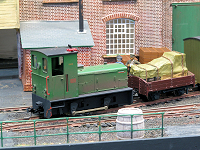
Owned by Andrew Dancy and built to 7mm/ft scale 16.5mm gauge '0-16.5'.
The layout depicts a brewery yard and as the name of the layout suggests describes the way the operators feel when they shunt it.
The fiddleyard is hidden in the Maltings building and deliveries come in from the great wide world through it. The brewery, like its name and operators, is somewhat stressed and empty wagons can often be seen aimlessly traversing its tracks. The bottling and barrelling plant is at the rear of the yard and has its own pointless track. The two steam locomotives were purchased by the brewery owners from other factories and having been shown to have their faults, a diesel locomotive was added to pull the owners out of trouble. The wagons are a motley collection of various vintages and origins.

The layout has had input from various people with the baseboard originally constructed by Greg Dodsworth and Ian Hopkins providing the buildings.
Brankstone '00'
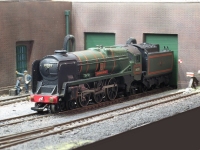
Owned by Roger Bradgate and built to 4mm/ft scale 16.5mm gauge '00'.
Built to show that small spaces do not prohibit a model railway and even downsizing on retirement does not end
a hobby that really can last a lifetime.
Brankstone is a locomotive depot built to relieve the existing Bournemouth area depots, it sits under commercial
warehousing behind which two branch lines converge. The period is set in the 1950 s/1960 s and with locomotives arriving from the
Somerset & Dorset line, in addition to some Southern and occasional Western region locomotives, a wide variety can appear.
Locomotives, suitably weathered to reflect the times, come from all current manufacturers but 1950/60s Hornby Dublo
and Tri-ang will also be found. With the Somerset & Dorset you could see anything even an ex-LNER B1 so Bulleids, Jinties, 4Fs,
7Fs, 8Fs, pannier tanks, Black Fives and Standard classes abound, whilst the branch lines see M7s on push-pull services, an 08 shunter
shuffling back and forth and because Roger spent many years travelling on them a two-car Hampshire unit shuttles on the rear branch line.
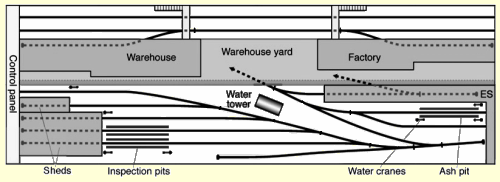
The layout measures 6ft 2in by 2ft with track Peco Code 100 using electrofrog turnouts of small radius and Y type. Roger has
used this track now for over 40 years and finds its strength and durability second to none and with careful painting and ballasting it has gained
many questions of is it finescale? The layout featured in the October 2016 issue of Railway Modeller.
Clerely End '0-16.5'

Owned by Peter Jackson and built to 7mm/ft scale 16.5mm gauge '0-16.5'.
The small quarry at Clerely in Dorset was established to extract the stone for buildings in the area. Initially, it was a very small enterprise, but in the late 1800s the owners decided to invest in a small narrow-gauge railway to transport the stone to the coast. This very soon covered its cost with the output of stone increasing rapidly.
The output of the quarry was limited by the lack of siding space for both empty and loaded wagons, so the owners built a short extension to Clerely St. Peter which gave them more storage space for the stone wagons, either empties waiting their turn to be loaded or loaded wagons waiting for a ship to berth before travelling down to the harbour where there was only space to unload. A limited passenger service was developed along with outward transport for local produce and inward transport for items such as coal. The small terminus station became known as the Clerely End, as opposed to the Harbour End.
The layout measures only 1.4 metres long by 30 centimetres deep and is operated by Digital Command Control (DCC) using an NCE Power Cab. This enables all the locomotives on the layout to be sound-fitted. Track and turnouts are Peco Streamline 0-16.5 Code 100. The buildings are scratch-built.

Locomotives are a mixture of kit or scratch-built bodies on kit-built or proprietary chassis. Most of the passenger stock is kit-built, either from Peco or Port Wynnstay, with nearly all of the goods stock being scratch-built.
The layout, originally constructed by Brian Cameron, has had various incarnations, names and owners during its lifetime. Peter hopes that his latest version will be of interest.
Courthare Junction '00'
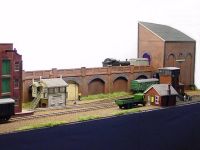
Owned by Andrew Dancy and built to 4mm/ft scale 16.5mm gauge '00'.
This 1ft x 4ft layout is the first that Andy has completed despite years of armchair modelling.
he has managed to get the maximum number of train movements into a minimum of space.
Portrayed is a fictitious junction set on the borders of the Great Western Railway and Southern Railway.

The GWR occupies the higher level, naturally so, as it is God s Wonderful Railway. Goods shunted
on the Southern lower level are exchanged with the GWR via a wagon hoist.
This wonderful machine, hidden in a brick building on the right of the layout raises and lowers loaded and unloaded wagons
from one level to another as if by the hand of God.
Itchen End Goods Depot '0'
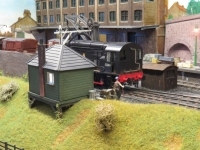
Owned by Brian Wilson and built to 7mm/ft scale 32mm gauge '0'.
The depot started life as a small country terminus but with dropping passenger numbers became goods only, serving the
existing warehouse and container traffic. The layout has been designed to show that you can have a micro layout in 0.

The two turnouts are operated by Tortoise point motors. Controls are DCC using a Gaugemaster Pro Plus. Most of the locomotives
have sound with stock fitted with Kadees.
Leysdown 'P4'
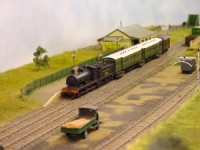
Owned by Adrian Colenutt and built to 4mm/ft scale 18.83mm gauge 'P4'.
Leysdown was originally built by the Uckfield MRC but is now owned by Adrian. This
was the Club's first essay in 4mm/ft scale P4 modelling.
Of the standard-gauge light railways of Kent, one of the most successful was the Sheppey
Light Railway, conceived by the islanders in the 1890s and engineered by the well-known
Holman F. Stephens. After being absorbed into the South Eastern and Chatham Railway the line
was improved, enlarged and partly standardized.Leysdown, the terminus, was the largest station
on the line and served the embryonic seaside resort offering limited facilities including cattle
pens along with a horse and carriage dock.
The layout comprises four 4ft x 2ft plywood baseboards with integral legs. Trackwork has
been built using ply and rivet construction to P4 standards on foam underlay. Turnouts are
operated by slow action Tortoise motors. A simple sector plate is used in the fiddle yard.

The buildings are scratchbuilt using a variety of materials, principally card & plasticard.
Use has been made of carpet underlay for the undergrowth with additional products from the 'Woodland
Scenics' range much to the fore.
Rolling stock is varied at the present time and may not be truly typical of that which ran on
the light railway. However featured are "B1" Class locomotive No 1021 and ex. S.E. & C.R.
articulated coach set No 514, both of which were photographed on the line in the mid 1930s.
Much thought has been put into the presentation of the layout with proscenium arch, lighting,
and a continuous full height backscene. The layout can be operated from the front or rear depending
on the operators or exhibition manager's preferences.
**For more information on the layout please go to www.leysdown.org.uk.**
Stourcombe '00'
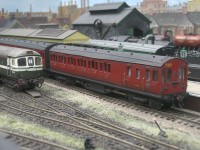
Owned by Roger Bradgate and built to 4mm/ft scale 16.5mm gauge '00'.
As a young lad Roger used to visit his grandparents near Bournemouth
every August. The only way to get there from his home town was to travel over the
Somerset & Dorset Joint Railway on the 'Pines Express' and for the young and
enthusiastic modeller this became a voyage of unparalled delight and lasting memories.
And so when it came to build a new layout for exhibition use it had to be of the S&D.
The layout can be exhibited in its original straight 16ft x 2ft format with 8ft being scenic and the rest
a working fiddleyard with hands free run-round or in a 'U' shaped format with the addition of a 6ft scenic section
making the layout 10ft x 6ft. Trackwork is Peco Code 100 allowing Roger to run some of his older rolling stock which
dates back to the 1960s and therefore has very deep wheel flanges. Turnouts and the Hornby-Dublo signals are electrically
powered via capacity discharge units by Gaugemaster who have also supplied the locomotive controllers and track cleaning
units.

Buildings are mainly from kits or Hornby's Skaledale range with just the dairy
and main timber yard scratch built. Ballast is a blend of fine Woodland Scenic types and most other
scenic materials come from the same range. The layout was featured in the February 2009 edition of
'Hornby Magazine'.
**For more pictures taken by Chris Nevard please click here.**
|